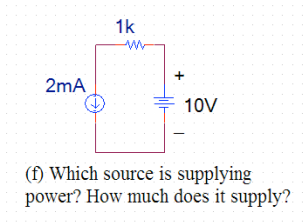Last week I asked a question involving a linear network involving ideal current and voltage sources. You guys gave me some great advice as to how to approach those types of problems. However, this example is really stumping me right now as the advice I was given on that post was to look at the circuit from one perspective at a time, first considering one type of source and then the other. However, I am having trouble applying this idea to this circuit diagram.
I was under the impression that if I consider the voltage source first, the current source should be interpreted as an open circuit. This, of course, breaks the circuit and no current can flow. I feel like this problem is more simple than I am making it out to be, but it's hurting my brain.
All that I've done so far is calculated that a circuit involving just the 10 V source and the 1k resistor would draw 10 mA. I just don't understand how adding a 2 mA current source changes this.
Any help would be greatly appreciated. Thanks!!!
Matt

